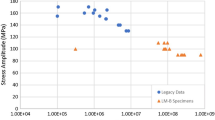Abstract
A literature survey gave preliminary evidence that large second phase particles were cracked under static loading and that these might subsequently be sources of fatigue crack initiation. In order to determine more fully the effect of this type of inclusions on crack initiation bulk samples of 2024-T3 material were strained to 6, 8, 10 and 12% and subsequently reheat-treated. Reverse bending fatigue specimens were then prepared for crack initiation studies.
Observations by optical microscopy showed that the prestrain had caused several voids at the inclusions partly by cracking of the inclusions while the more probably event was failure of the matrix-inclusion interface. It was shown that the voids were sources of fatigue crack initiation. Tests on as received material indicated initiation to occur also at inclusion clusters. Repeated polishing revealed the complex three-dimensional nature of the inclusions and its significance for the local direction of crack growth.
Résumé
Un examen de la documentation technique a mis en évidence que sous une charge statique, des criques se forment dans des grosses inclusions et qu'à partir de celles-ci peuvent s'initier des criques de fatigue. Pour établir d'une façon plus complète l'effet de ce type d'inclusions sur l'initiation des criques, des échantillons de 2024-T3 on été sollicités en traction jusqu'à 6, 8, 10 et 12% et ensuite de nouveau soumis à un traitement thermique. Des éprouvettes étaient prélevées et des essais de fatigue faits en flexion pour étudier l'initiation des criques.
Des examens au microscope ont montré que la précontrainte avait produit plusieurs trous aux inclusions, en partie par la formation des criques, le phénomène le plus probable étant cependant la défaillance de l'interface matriceinclusion. Il a été montré que les trous sont à l'orgine de l'initiation des criques de fatigue. Des essais sur du matériau tel qu'il était reçu ont indiqué que l'initiation se produit aussi sur des amas d'inclusions.
Un polissage répété a révélé la complexe nature tri-dimensionelle des inclusions et son importance pour la direction locale de l'accroissement des criques.
Zusammenfassung
Es hat sich im Literatur gezeigt daß groben intermetallischen Einschlüsse unter einem statischen Last angerissen wurden und daß nachdem an diese Stellen vielleicht Ermüdungsrissen entstehen können.
Um den Einfluß dieser Teilchen besser zu deuten, wurden Proben von 2024-T3 Material einer plastischen Dehnungsamplitude von 6, 8, 10 oder 12% unterworfen, nachdem die Proben aufs neue eine Wärmebehandlung gegeben ist. Biege-ermüdungsversuche wurden denn gemacht zur Untersuchung des Entstehens der Ermüdungsrisse.
Optische Mikroskopie hat dann gezeigt daß die Vordehnung sämtlichen Mikrohohlräume an der Teilchen hervorgerufen hat, zum Teil durch Anreissen des Teilchens; des mehr annehmbare Vorfall war jedoch Dekohäsion zwischen den Einschlüsse und der Matriz. Es hat sich gezeigt daß an der Stelle der Hohlräume Rissen entstehen. Prüfung des selben Materials in der Anfertigungszustand hat gezeigt daß auch dann die Rissen entstehen an der Stelle von zusammengetroffenen Teilchen. Wiederholtes Polieren zeigte den komplizierten drei-dimensionalen Aufbau der Teilchen und dessen Bedeutung für die lokalen Richtung der Rißfortschritt.
Similar content being viewed by others
References
J. Schijve, Fatigue Crack Propagation, ASTM STP 415 (1967) 415.
D. Broek and C. Q. Bowles, J. Inst. Metals. 99 (1971) 255.
H. P. van Leeuwen, Nat Aerospace Lab. NLR Amsterdam, Report MP 70015, 1970. (to be published in Jour. Inst. Metals).
R. M. N. Pelloux, Trans. ASME, 57 (1964) 511.
D. Broek, Fracture 1969, Ed. P. L. Pratt, Chapman and Hall, London, (1969) 754.
D. Broek, Doctor Thesis, Delft Un. of Tech. (1971). (See also NLR Report TR 71021).
L. H. Glassman and A. J. McEvily, NASA TN D-928 (1962).
M. R. Hempel, Fracture, Technology Press MIT (1959) 376.
J. C. Grosskreutz and G. G. Shaw, Fracture 1969, Ed. P. L. Pratt, Chapman and Hall, London (1969) 620.
J. C. Grosskreutz, Fatigue mechanisms in the sub-creep range, Metal Fatigue Damage, STP 485, Amer. Soc. for Testing Materials (1971) 5.
A. J. McEvily and R. C. Boettner, Fracture of Solids, Interscience Publishers, (1963) 383.
P. J. E. Forsyth and A. C. Smale, Roy. Aero. Est., Tech. Rep. 68205 (1969).
S. Morykwas, Metal Progress, 93 (1968) 115.
Author information
Authors and Affiliations
Rights and permissions
About this article
Cite this article
Bowles, C.Q., Schijve, J. The role of inclusions in fatigue crack initiation in an aluminum alloy. Int J Fract 9, 171–179 (1973). https://doi.org/10.1007/BF00041859
Received:
Issue Date:
DOI: https://doi.org/10.1007/BF00041859




